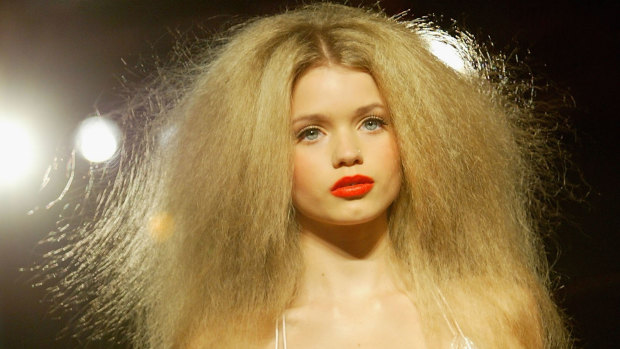
Launched in 1996 by Simon Lock, Australian Fashion Week once crackled with verve and Veuve Clicquot, with department stores David Jones and Myer fighting over brands such as Ellery and Maticevski.

Abbey Lee at the Lisa Ho show for Australian Fashion Week in 2004.Credit: Getty Images
As the influence of department stores in the fashion space slowly surrendered to digital dealers, the fizz and sparkle fell flat.
Visiting international buyers have slowly diminished in stature as the need to travel to Australia to see collections has dwindled. Many emerging designers already have relationships with buyers at Net-a-porter and Selfridge’s in the UK, long before considering a runway show.
If you landed in the front row in the on-trend golden years at Fox Studios and then Circular Quay, you could have rubbed shoulders with ItalianVogue’s Anna Piaggi or supermodel Jerry Hall. This year at Carriageworks in Redfern you were lucky to be seated with a Married at First Sight survivor.
While Australian Fashion Week’s relevance has been reduced, there have been welcome signs of change. The recent spotlight on emerging designers such as Jordan Gogos, First Nations labels, like Ikuntji Artists and Ngali, and adaptive brands have promoted greater inclusivity.
Loading
IMG also borrowed from ticketed events such as the Melbourne Fashion Festival and expanded beyond being an event purely for the industry. But somehow, along the way to becoming an event for everyone it faces a future with no one watching.
Unfortunately, fashion insiders are not enthusiastic about inspecting next year’s collection while ticket-buying mothers, with daughters dressed as Disney princesses in tow, pretend they’re in an episode of Emily in Paris.
Watching online you won’t risk having a juice box spill on your Prada skirt.
The Australian Fashion Council, a non-government membership organisation advocating for the fashion and textiles industry, was quick to appoint itself to lead the conversation about the event’s future.
“This moment signals an opportunity for the industry to reimagine and reshape how Australian fashion is represented, and provides us all with an opportunity to explore new ways in which to showcase emerging and established Australian talent,” says a joint statement from chairperson Marianne Perkovic and chief executive Jaana Quaintance-James.
Designers I spoke to who have participated in previous fashion weeks and feel unrepresented by the AFC are already looking at alternatives.
Finding sponsors for future events is another challenge. Many brands, such as former event sponsor Mercedes-Benz, now prefer the buzz of art events at the National Gallery of Victoria over fashion. The allure of sitting front row has gone, along with the celebrities.
It’s always sad to see something reach an end. Australian fashion needs a voice, just like Farnham. It might just be that a week of runway shows has nothing left to say.
Make the most of your health, relationships, fitness and nutrition with our Live Well newsletter. Get it in your inbox every Monday.




























